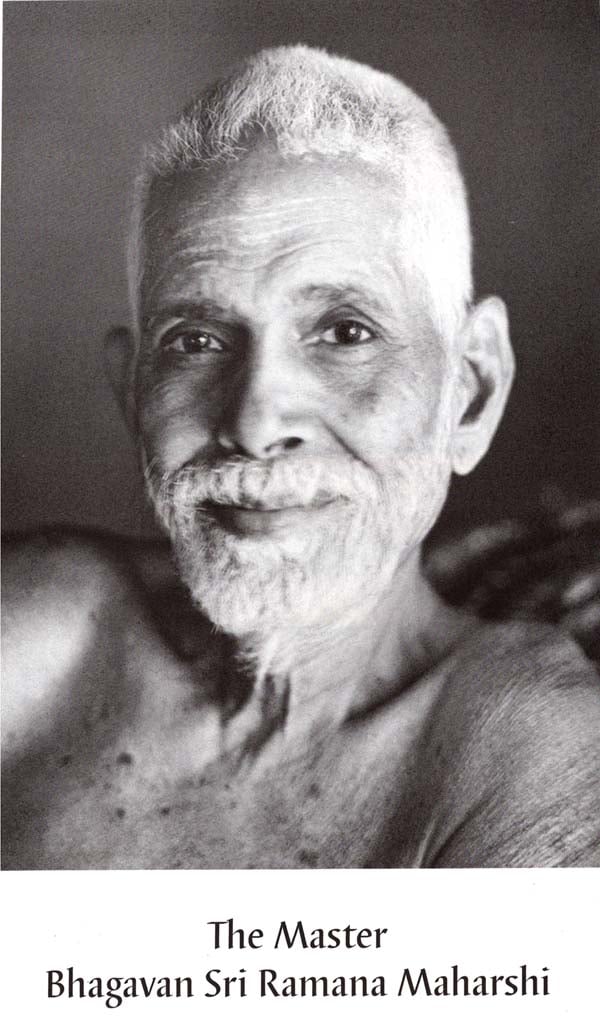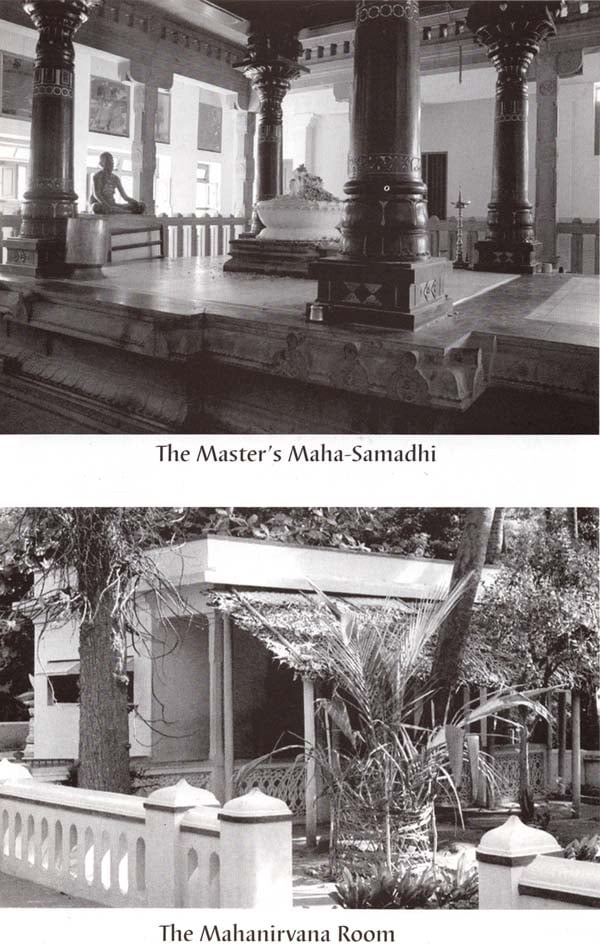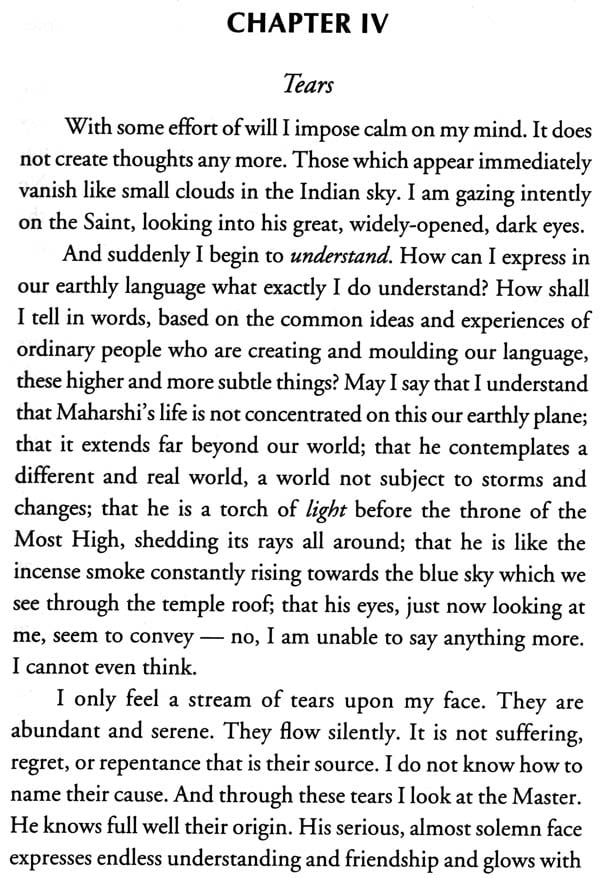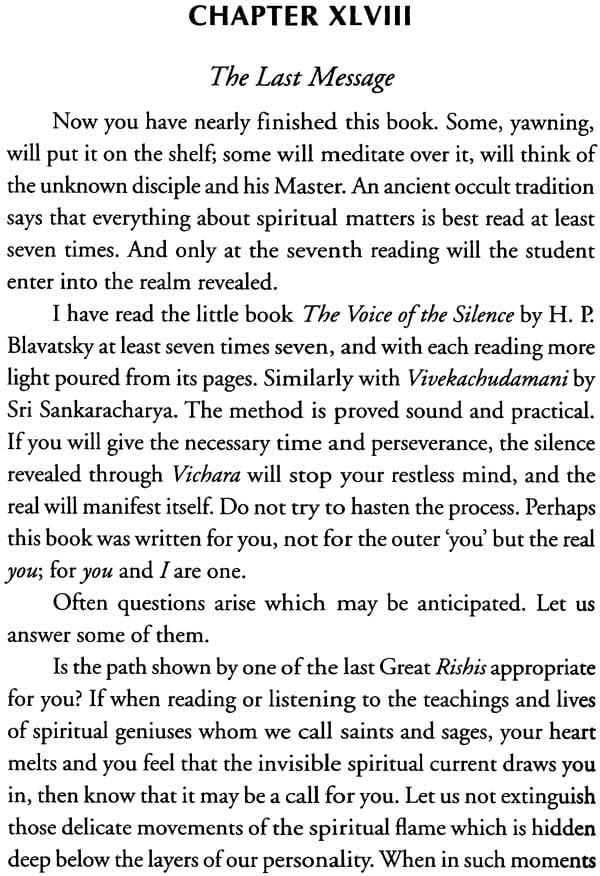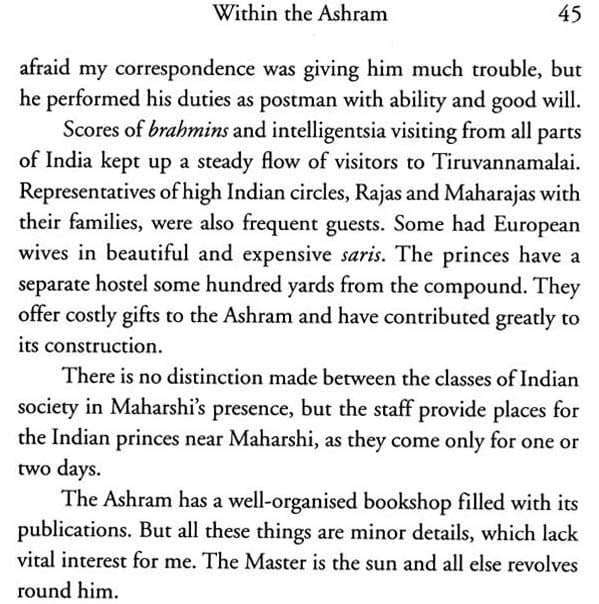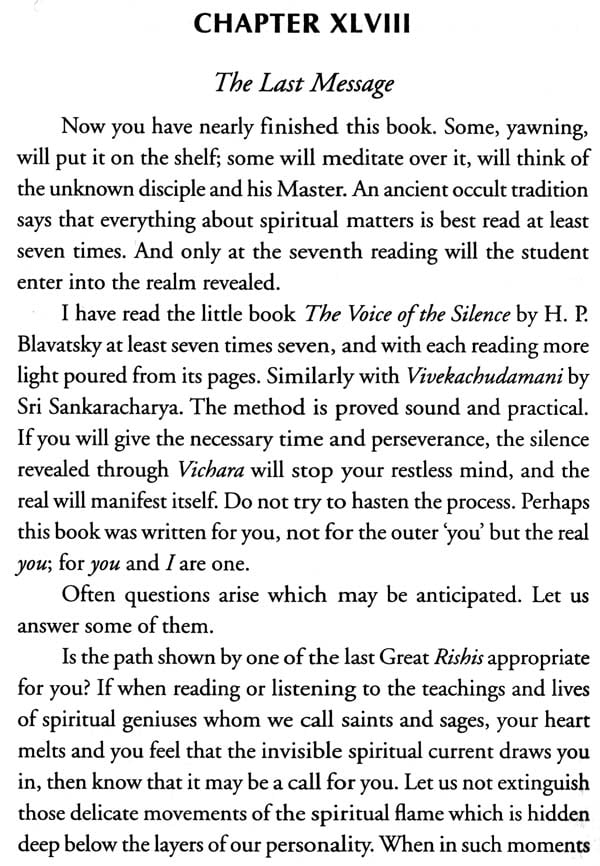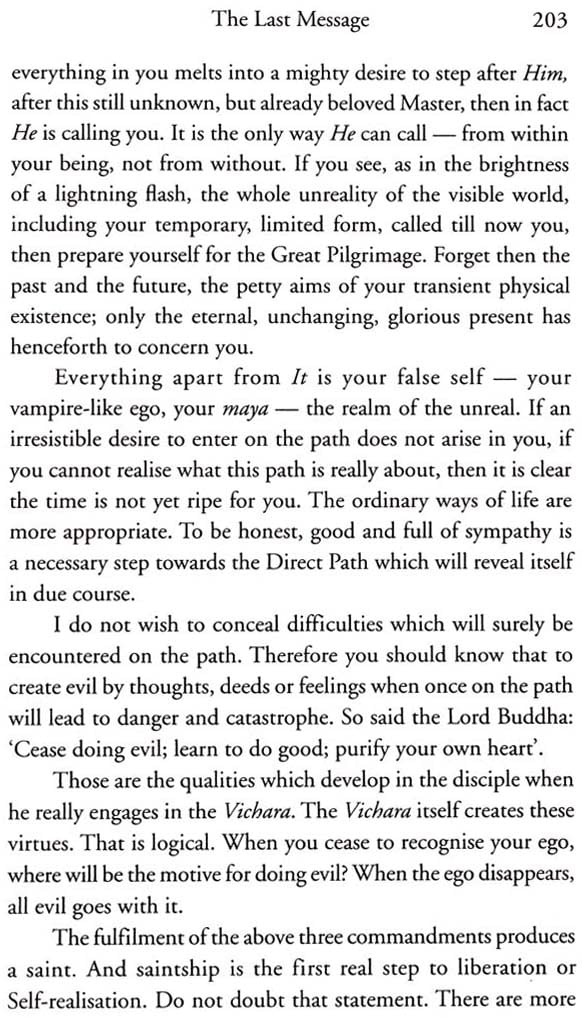
In Days of Great Peace
Book Specification
| Item Code: | NAP018 |
| Author: | Mouni Sadhu |
| Publisher: | Sri Ramanasramam, Tamil Nadu |
| Language: | English |
| Edition: | 2016 |
| ISBN: | 9788182882416 |
| Pages: | 236 (1 B/W Illustration) |
| Cover: | Paperback |
| Other Details | 8.5 inch X5.5 inch |
| Weight | 280 gm |
Book Description
This popular book, recounting the author’s visit to the ashram of sri Ramana Maharshi in 1949 has inspired many westerners to seek spiritual guidance from Sri Ramana Maharshi in the years following His Mahasamadhi.
Through a narrative that is both simple and profound, the author takes us on his journey to the quiet hermitage of the renowned sage of Arunachala in South India. Basking in the radiance of the ‘Great rishi’, his mind turns inward, following the path of Self-inquiry of Who Am I?”. He describes, with perceptive insight and emotion, how in the gracious presence of the Master, thoughts are stilted and one rests calmly in the thought-free egoless state, which is called Samadhi. Before his final farewell of the holy Sage, he establishes the link of love that binds him to the Guru in an embrace that leads inevitably to final emancipation.
Mouni Sadhu has left us a small treasure in this book. Readers will remember and cherish it through-out their lives.
When you have a dream, your mind creates all the people and event in it. They have no reality apart from you, and their creation takes nothing from you and their re-absorption adds nothing to you; you are the same after as before. It is something like that with the manifestation of the universe.
You cannot be outside the spirit or other than it, because there is no other. If you discover the real self of you behind all thoughts and feelings, it is Spirit, the self of all; Whether you discover it or not, only the self is.
Why, then, should one trouble to discover it? Because by breaking through illusions of a separate individuality and discovering the One Self, suffering and frustration is avoided and strife replaced by a vibrant Peace, sorrow by a luminous Bliss.
The Oneness of Being is the ultimate truth behind all religious and all occultism and esoterism, although some may have lost sight of it. It is known in Hinduism as ‘Advaita’, Non-Duality. The three Western religions and some schools of Hinduism have veiled it behind the less direct teachings of a Personal God who creates and rewards and punishes. Their teachings is true but not the ultimate Truth. So long as the ego persists in the illusion of its own reality, the Self is the God who creates it. The self d=drawing it back is the love of God for his creature. The self drawing it back is the Love of God for his Creature. The Law of Karma, that is of cause and effect (‘They shall be paid back to the uttermost farthing’) is the reward and punishment of God. The mind can be in a state of consciousness that is heaven or that is hell according to its past thoughts and deeds. Therefore no exponent of Advaita denies the truth of the religion of a personal God; only for those who are willing to understand he explains that this is not the ultimate truth.
Advaita is not a philosophy; understanding it mentally is only a preliminary to seeking true understanding through the spiritual guidance of a Master. Through the world today it has become difficult to find a true master, as it has been in the West for several Centuries past. In the midst of this darkness, Sri Ramana Maharshi, called by his disciple Bhagavan or ‘The Divine’ dwelt on earth among us to guide all who turned to him from all religions. He is the light and the truth; he was the man in perfect Oneness with the Spirit, always, in speech and action no less than in silence and inaction; and he dwelt here to guide those who turned to him from darkness to light.
Mouni sadhu had spent half a lifetime searching for truth or for guidance to truth before he was drawn to the feet of the Maharshi and his search for a Master rewarded.
Small wonder that he was lifted up to ecstatic experiences. Many who seek and some , perhaps , who have not yet realised the need for search or the possibility of anything higher than the life of body and mind , will be encouraged by the account the Maharshi in physical form as he did , his Grace is outpoured on all those who turned to him and no effort of theirs will be wasted .
For all such, this book may be more than a curiosity; it may be light kindling a responsive light in the heart and pointing the way where all seemed darkness before.
The first edition of this book was published in October 1952 under the title in days of Great Peace… Diary Leaves from India. Following the advice of numerous friendly opinions and many favourable reviews by expert in India and the West, it has been decided to make the revised version slightly longer by some additional chapters based on my old dairy and to change the subtitle.
In expressing my own experiences it has seemed best to use as simple a form as possible ,avoiding technicalities and classical yogic terms, which might tend to confuse the student if he is not acquainted with them. In conveying spiritual matters , it is necessary to avoid overburdening the mind, for it distracts the attention, and the main message is not absorbed.
As well as the words of Sri Maharshi spoken in my presence , I have used quotations from the published teachings of the sage , which were revised and acknowledgment by him. They are: Self-Realisation. Life and teachings of Sri Ramana Maharshi by B. V. Narasimha Swami , Third edition ,1936
Maha Yoga by ‘Who’ Third edition, 1947
Maharshi’s Gospel, fourth edition, 1946
Five Hymns to Sri Arunachala by Sri Maharshi, third edition, 1946
Spiritual instruction and Who Am I? two small books compiled from the teachings to his early disciples between 1900 and 1902.
Since Sri Maharshi passed away from the body on 14th April,1950. Some ‘new’ interpretations and quotation of hi saying have appeared in books written by former inmates of the Ashram. They may be correct, but I prefer to limit myself. I have given the reader an account of what I myself experienced , taking full responsibility for the accuracy of what I have written.
The teachings of the Sage, passing through the consciousness of each student , must vary in accordance with each one’s development ,zeal and practice . The teachings itself is so simple that there cannot be any great variation in its main theme , but individual interpretations can differ on unessential points . the truest interpretation is that which arise in the heart of the pupil under the grace of the Master.
True realisation does not come from any mental study of the letter of the teachings , neither is a man drawn to attempt the ‘Direct path’ because of the accuracy of any biography of the Rishi.
At the beginning of this century a western master said: ‘One who leaves this earth spiritually blind, will remain so after death’. That is to say , the fact of leaving the body does not, of itself , bring spiritual enlightenment . Sri Maharshi often emphasised our need to attempt to experience realisation here and now, and no spiritual Master ever contradicts another ; Saints and Yogis realise the urgency of the matter , and do not postpone it to some future, unknown state.
Since realisation is nothing more than the raising of our consciousness to the level of reality -Spirit -Self , which means transcending the so-called ‘normal’ consciousness of the brain -mind or ego , there must inevitable occur some forms of super -consciousness or samadhi. These ecstatic experiences are necessary before the final perennial sahaja samadhi can be attained. In the west, some call these samadhis ‘initiations’.
When Sri Maharshi was asked why he did not pass through these ’initiations ’in his life , but almost immediately reached sahaja Samadhi, he replied that one who pervious initiations in a past life.
So we may accept the fact that these spiritual experiences are necessary before we can reach the state of the ’Liberated’ the Rishi, the Jivan Mukta,or simply , the Master . The terms are synonymous.
| FOREWARD TO THE FIRST EDITION | v | |
| FOREWARD TO THE SECOND EDITION | vii | |
| INTRODUCTION TO THE SECOND EDITION | xi | |
| INTROUCTION TO THE FIRST EDITION | xv | |
| 1 | Association with the Sages...' | 1 |
| 2 | The first Meeting | 3 |
| 3 | Lfe in Maharshi's Ashram | 5 |
| 4 | Tears | 13 |
| 5 | The Glory of the lord is Manifested in His Saints' | 16 |
| 6 | The Man sri Maharshi | 19 |
| 7 | A Wish Fulfilled | 24 |
| 8 | Love | 26 |
| 9 | My Path to Mahrashi | 31 |
| 10 | As by mixture with water...' | 41 |
| 11 | Within the Ashram | 44 |
| 12 | Teachingsof Maharshi | 46 |
| 13 | The direct Path | 51 |
| 14 | The Technique of Vichara | 59 |
| 15 | Martha, martah, thous art careful...' | 63 |
| 16 | The Last Photograph of the Master | 66 |
| 17 | One Operation more | 69 |
| 18 | Visiting Caves | 72 |
| 19 | Arunacala by Day | 76 |
| 20 | The I Current' | 81 |
| 21 | The Tomb of the Muslim Saint | 83 |
| 22 | In Sri Aurobindo's Ashram | 86 |
| 23 | The Darshan resumed | 92 |
| 24 | Initiations | 97 |
| 25 | A Musical Performce in the Temple hall | 100 |
| 26 | Apart from the mind | 103 |
| 27 | stray Leaves | 109 |
| 28 | The Eyes of Maharshi | 112 |
| 29 | Asperges by hyssopo' | 115 |
| 30 | Arunacala by Night | 119 |
| 31 | God | 124 |
| 32 | Some Remembrances | 129 |
| 33 | Power in Us | 134 |
| 34 | Correspondence | 138 |
| 35 | I and you | 147 |
| 36 | Requiem | 150 |
| 37 | The Last Days | 155 |
| 38 | My New Conception of life | 161 |
| 39 | Seek ye First the Kingdom of God' | 163 |
| 40 | What is Meditiation? | 167 |
| 41 | Techniques of Meditation | 171 |
| 42 | Deparure | 175 |
| 43 | Farewell | 179 |
| 44 | Colombo | 182 |
| 45 | On the Screen | 187 |
| 46 | The Light is Shining | 191 |
| 47 | Samadhi | 194 |
| 48 | The Last message | 202 |
| 49 | Epilogue | 206 |
| 50 | Appendix- Matter for Meditation | 210 |
